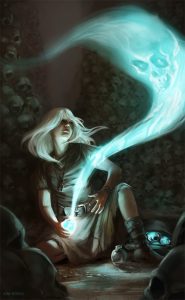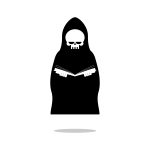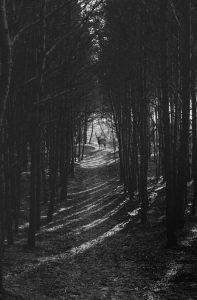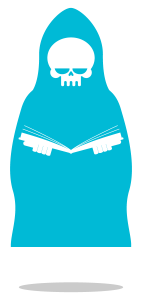Artist Interview with Kim Sokol
 The Ghost Thief is a young woman, sitting alone in a cavern. She’s surrounded by dirt and death but despite it, or maybe because of it, she’s at peace. There’s no fear, just calmness. Her bag is filled with bottles that must have clinked and echoed as she navigated the walls of skulls. As she sits there, bottle in hand, the question lingers: is she freeing the souls…or trapping them?
The Ghost Thief is a young woman, sitting alone in a cavern. She’s surrounded by dirt and death but despite it, or maybe because of it, she’s at peace. There’s no fear, just calmness. Her bag is filled with bottles that must have clinked and echoed as she navigated the walls of skulls. As she sits there, bottle in hand, the question lingers: is she freeing the souls…or trapping them?
Kim Sokol is a Canadian, Kingston-based illustrator. Like many creative people, Kim started at a young age. When Kim was 12, fandom influenced her artwork. She printed tutorials and penned images from Pokémon and Dragonball Z. Kim was always working on a project. “As a kid, I made crafts, drew, wrote, even made a cursory attempt at music, and for a while in my preteen years I figured I’d grow up to be a writer.”
Writing and art have always been linked for Kim. Drawing became an “outlet for the stories that [she] couldn’t let out.” Even when she was little, Kim told her Nana that she wanted to grow up to write books and draw the pictures. Though it seemed like just a childhood fantasy, Kim wasn’t wrong or even that far off. Kim wrote and illustrated a short book of horror stories for her college graduation project. Kim still writes, she just keeps her work private. For her, writing is far more personal, a sentiment that many writers can identify with. “I can’t handle sharing my writing, and I can’t take criticism on it ̶ no matter how abstract and fantastic, it always feels kind of like letting people read my diary.”
Kim currently works as a freelance illustrator. You might have even seen some of her art in the gaming or publishing industry. Kim has worked with clients like Angry Robot Books and Fantasy Flight Games. Despite freelancing being susceptible to high stakes, bad days, and mountainous work, Kim always accepts that freelancing is the path she chose. She’ll climb that mountain just out of sheer stubbornness.
“I’ve chosen this career, I knew what I was getting into, and failure is not an option. On a rough day, even the smallest step forward is still a step forward.”
When she’s working, Kim structures her day so that she can gather momentum and motivate herself. She can be a night owl and will often start her day in the early afternoon, knowing that she might be working until the early morning. To make sure she stays focused and sets reasonable goals, Kim also breaks her working hours into hour-long or half-hour long chunks. Often Kim will be working on multiple stages of projects, so when her attention starts lagging, she can “swap between thumbnailing, drawing, and painting.”
Kim studied illustration at Sheridan College. The program focused on developing an individual style for editorial illustrations. Editorial illustration is the design that complements written content; and “is often more conceptual than narrative”. While digital painting was Kim’s first love, she spent four years developing an ink/ watercolor/digital style. When she graduated with a portfolio of editorial illustrations, Kim realized that she wanted to pursue her own style.
“I finally realized, after taking far, far too long, that wait a second, I hate editorial illustration. I respect the hell out of it, but I love digital painting. I love narrative. Why am I fighting to build this editorial portfolio when I could just be painting pictures of elves with swords?”
She fell headfirst into fandom, playing World of Warcraft, Magic: The Gathering, and Dungeons & Dragons. She also started developing a daily art piece, which required research into weird themes, subjects, and media.
Although she creates fantasy-based images, Kim never shies away from research.Her reference folder has “over 25,000 images in it.” Along with sketching and looking for reference images to ground her work, Kim also considers the time and place she chose for her setting. She wants to understand every aspect of her piece, whether it’s the construction of a ship or the movement of a dinosaur.
“Illustration often feels more like building a house than painting a painting–every stage builds on the stage before. It doesn’t matter how pretty your house is if the foundation crumbles.”
If you view Kim Sokol’s portfolio, you’ll notice that her art often features female characters at the center. Sometimes these female characters are peaceful, other times they’re armored warriors. There are different types of strength and Kim is eager to showcase more than just a “buff lady with a cool sword.” Kim wants her heroines to be “calm, in control, and totally unconcerned.”
“As a person with a history of severe anxiety problems, serenity in the face of power and danger is a type of strength that inspires me a lot.”
When it comes to the question of The Ghost Thief, and the character’s intentions, Kim doesn’t favor any particular reading. She wants to guide viewers to a story, giving them the outline with her images, and then leaving them with the uncertainty. She says that her “favorite thing is creating work where you can feel a deep story behind it, but only enough to make the viewer want to fill in the blanks.” Admitting her original intention was a witch “bottling lost spirits for questionable usage,” Kim is also happy with the ambiguity that the witch “stole them from elsewhere and is bringing them home.”
Kim wants to create art that “makes people want to tell their own stories.” She has a drive to create art and knows that even had she chosen a different career, art and creativity would still have been a part of her life. While she may strive for ambiguity in her art, there’s no doubt that Kim Sokol is dedicated, talented, and sincere.
“I think the sticking point was this: I was going to be making art no matter what I did… This isn’t the easiest job out there, it’s hard to find work at all and sometimes sitting down at my computer is like pulling teeth, but I don’t regret my direction for a second. Even when it’s a struggle, I’m making new things every single day.”
Full Interview with Kim Sokol
- Tell me a bit about yourself. Who are you, where did you grow up?
I’m Kim. I’m 30 years old and grew up about 40 minutes out of downtown Toronto, Ontario. I went to school at Sheridan College in Oakville and now live in Kingston. I make a living as a freelance illustrator.
- Why did you become an artist?
I need to make art.
I think most creative people understand that drive; while there’s no outside force pushing us towards it, sometimes you just don’t feel right if you’re not creating. As a kid, I made crafts, drew, wrote, even made a cursory attempt at music, and for a while in my preteen years I figured I’d grow up to be a writer. But I can’t handle sharing my writing, and I can’t take criticism on it—no matter how abstract and fantastic, it always feels kind of like letting people read my diary. It’s too close to home.
I started drawing when I was 12 in 1999, fueled by Pokémon and Dragonball Z, printing how-to-draw tutorials off Geocities sites. It was an outlet for the stories I couldn’t let out any other way. Even then, I wasn’t sure if this was the direction I wanted to go with my life. I had the grades to do whatever I wanted, and, for a while, I seriously considered computer science because I actually love programming.
I think the sticking point was this: I was going to be making art no matter what I did. If I had a lucrative day job I’d just be scrounging all the money and spare time I had to make more art. This isn’t the easiest job out there, it’s hard to find work at all and sometimes sitting down at my computer is like pulling teeth, but I don’t regret my direction for a second. Even when it’s a struggle, I’m making new things every single day.
My Nana says that when I was very small, I told her when I grew up I’d write books and draw the pictures. My college grad project was a short book of 3 horror stories that I put aside my writing-aversion long enough to put together, accompanied by my illustrations. I took a winding path, but I got there in the end.
- How do you work? When you’re ready to start working on a piece of art, what do you do with your day?
I have a pretty bad attention span, so I love to have multiple things to work on at the same time. Even better if they’re all at different stages—being able to swap between thumbnailing, drawing, and painting is great. I like to break up my time into hour-long or half-hour long chunks (partially because it’s a reasonable goal to stay focused, partially just because I like being able to easily track my time). I also do a daily study and post them online at artbetter.tumblr.com. Every day is different, and I’m a night owl, so often I’ll sleep late and not start working ’til early afternoon, but I’m often still going at 4 AM.
- What was the most important advice you learned from your degree?
My work looks wildly different than it did when I graduated. Sheridan College’s Illustration program focused heavily on editorial illustration and about finding your style for said editorial illustration. After spending four years developing an ink/watercolour/digital style, it took me a couple of years to get back to the digital painting I’d loved all along.
That’s not to say I learned nothing from my degree though; the most important thing I learned was how to think. Brainstorming and conceptual thinking is a hugely important part of illustration, both conceptual and narrative. For skills more specific to the sort of work I’m doing now, I actually learned more in my three 1-week stints at the Illustration Master Class, an incredible and worthwhile program.
- Kingston is a city with a lot of history to it. Do you find yourself adding hometown details to your artwork?
Not particularly, though I really should. The Kingston waterfront is one of my favourite places in the world and I keep meaning to sneak that shoreline in somewhere.
- What do you do to decompress after a hard day?
I don’t honestly have a lot of hobbies outside of art; it’s sort of all-consuming. The two things I have are video games—which I play intermittently and with a great deal of guilt—and watching pro wrestling. (I can’t explain the wrestling. I’m two years into this particular fandom and I still don’t know how I got here.) Other than that, it’s just the usual social media hole. Too much time on Tumblr… mostly spent writing about wrestling. Yep.
- What themes do you often pursue with your artwork?
Well, I like powerful women and I like diversity. I think that’s pretty up-front in everything I do. I also love storytelling and ambiguity. My favourite thing is creating work where you can feel a deep story behind it, but only enough to make the viewer want to fill in the blanks.
- What memorable responses have you had to your work?
Like I said, I love making work that inspires people to come up with their own stories, something that hints towards a story just enough to feel like a part of something.
At Gen Con a couple of years ago, I was selling a portrait of an orc in a flower crown, and surprisingly nearly everybody who passed by felt compelled to tell me their take—he reminded them of their D&D character or their friend’s, he was a pacifist, he was confused, he was given flowers by his child, she was an orc bride on her wedding day…
Likewise, there was another piece of an enormous steampunk construct tutoring a couple of children in a library, and it got a lot of comments, but seemed split down the middle as to whether it was a sweet scene or a creepy one. The fact that both were strong, sincere responses meant a lot to me.
- Why have you focused your art on fantastical imagery?
The long answer: Like I said, I left college with an editorial style. I spent my first year out of school trying to work out a living situation that kept falling through, living with my parents, trying to find the drive to work on and promote my portfolio, mostly playing a lot of World of Warcraft and sleeping. That very first summer after graduating, I spent nearly two months total, in multi-week bursts, sleeping on the couch of a friend in Kingston. I visited a couple more times over the year, becoming part of a giant nerd group that played Magic: The Gathering and D&D.
Starting in January 2010, still at home, I started a project where I did some sort of art piece daily, with each month on a weirdly specific theme. This got me digging into different subjects and media, and that summer I decided to hell with it, I love Kingston and I’m moving there.
Falling even deeper into that nerd circle, I finally realized, after taking far, far too long, that—wait a second—I hate editorial illustration. I respect the hell out of it, but I love digital painting. I love narrative. Why am I fighting to build this editorial portfolio when I could just be painting pictures of elves with swords?
It took a couple of years after that to up my skills and get my foot in the door in the business. I mostly supported myself with graphic design. But remembering what made me an artist in the first place changed everything. This is the style I love, and this is the corner of the business that appreciates this style the most.
The short answer: It’s just what I have the most fun painting.
- What type of research do you do before working on a new piece?
My first step on nearly every piece is to gather as much reference as possible. I hoard reference images (my reference folder has over 25,000 images in it so far), so a lot of it’s just scrolling through my collection and dumping anything relevant into a folder. This is especially important for things like costume design, because this process lets me bring in details and inspiration I probably wouldn’t have come up with if I just googled around for what I thought I needed.
Then I go looking for information on anything that requires further digging. For example, if I’m painting something on board a ship, I don’t just need reference images, I need to read up to make sure I understand the relevant era, what various parts are for so I don’t place them incorrectly, etc.
I also draw studies in my sketchbook or paint them in Photoshop to get a handle on shapes and construction I don’t necessarily understand. I recently painted a dinosaur, and for that I didn’t just study other artists’ interpretations, I also wanted to have a good idea how they might move. I sketched some gesture studies of running ostriches, a pretty good stand-in for a two-legged dinosaur.
- Do you listen or watch anything while working?
I can’t work in silence to save my life. Occasionally music is enough but usually I’m on podcasts, audiobooks, YouTube, streamers… YouTube gamers or Twitch streamers make great background noise sometimes. I like putting on lets plays of games I’ll never have the time to play, or just listening to somebody like Day[9] on Twitch ramble about nothing.
- What gives you the most trouble when working on a new piece?
Just starting out! The first stage, ideation and composition by thumbnailing, is always the hardest step of any image. Illustration often feels more like building a house than painting a painting—every stage builds on the stage before. It doesn’t matter how pretty your house is if the foundation crumbles. Nailing that foundation is key. Sometimes it’s stressful to finally to decide, “This is good enough, I can move forward now.”
- What would make you abandon a current artwork?
Losing momentum. I try to take everything I do through to a finish (and certainly would never put client work aside) but sometimes paid work takes me away from personal work for a little too long. Sometimes client work means pushing through to the end on a piece I have little passion or motivation for. I don’t want to have to do that on a personal piece when I’ve lost the initial excitement.
- Freelancing can be an easy way to burn out. How do you keep yourself motivated and accountable to yourself and your clients?
The honest answer is that I burn out a lot. Knowing the stakes helps push me forward with client work—nobody wants to work with an unreliable illustrator, and art directors talk to each other—but often, once I get out from under a pile of work, it takes a good while to fill up those depleted energy reserves and tackle the next thing. In that case, my biggest motivator is sheer stubbornness. I’ve chosen this career, I knew what I was getting into, and failure is not an option. On a rough day, even the smallest step forward is still a step forward.
- Fan art is a huge part of building an online audience, how do you balance fanwork with original designs?
I honestly don’t do much fan art these days, but for the past decade or so fan art has sort of been my play space. I’ll use it to mess with techniques and pastiche. In the past I’ve done fan art in the style of pulp novel covers, boxing posters, art nouveau, stained glass windows… lately, most of my “fan art” has just been studies that I’ve pushed a little farther.
Usually I find fan art is a pretty bad way to build an audience unless you do loads of fan art of the same thing. However, I’ve done some paintings of my favourite pro wrestlers, and the wrestling fandom seems weirdly likely to stick around for fantasy art. (The other fun part of wrestling fandom is that they’ll often comment on and reshare fan art. One of my favs even used my art as her twitter icon for a few months!)
- You’ve worked with a lot of publishing companies. If you had a choice, what would be the perfect novel to accompany your art?
Something starring a cool, powerful lady, probably. I know what I’m about. Give me a 15-book series about a bunch of women being total badasses and I’d be over the moon.
- What kind of books/stories inspire you?
Maybe surprisingly, I love urban fantasy and horror more than I love high fantasy. The aesthetic of fantasy appeals to me far more than the stories themselves. What inspires me most, though, is tabletop roleplaying and the stories we make ourselves. The participation makes it feel much more personal, and the collaborative aspect keeps the story unexpected. That’s my primary interaction with the fantasy genre, which is probably why I still get so hyped about fantasy despite reading very little of it. Having a personal, emotional connection makes it resonate much deeper.
- Is there a novel or story that you return to, over and over again? Has it influenced your work?
Honestly none of my top favourite books are in the fantasy genre at all! Three are genre comedies and one is a weird deconstruction of what literature even is.
- Hitchhiker’s Guide to the Galaxy
- Good Omens
- House of Leaves
- John Dies at the End
Actually, though, if comics count —Neil Gaiman’s Sandman was probably way more formative than I’ve ever considered.
- One of my favourite things about The Ghost Thief, is the look of calmness and pride on the woman’s face. What were you thinking about when you created this character?
Like so many female artists, I care strongly about so-called “strong female characters,” but a lot of kinds of strength interest me just as much as a buff lady with a cool sword. As a person with a history of severe anxiety problems, serenity in the face of power and danger is a type of strength that inspires me a lot.
A woman with little apparent physical strength, but who is calm, in control, and totally unconcerned is a theme I’ve come back to many times over the years. (The hard part is communicating intent! With a couple of pieces in the past, I’ve gotten“Why is she smiling like that if she’s fighting?” comments. And as an illustrator, I can’t just say they’re reading it wrong; it’s on me to get the message across. That’s my job.)
- The background details of the Ghost Thief are gorgeous. Did you imagine a story behind the picture?
The background was inspired by the Paris catacombs, just these endless tunnels lined with human skulls and bones. The story I pictured was a witch of sorts going into a similar place and bottling lost spirits for questionable usage, though I’ve seen another reading—there’s that ambiguity again—that she stole them from elsewhere and is bringing them home. I’m fine with either take.
- It seems that a lot of your art feature female characters at the centre. Is there a reason?
As well as the reasons listed earlier, honestly a lot of times I’ll sit down with the intention to paint a piece with a guy in it, and a small, whiny part of my brain goes, “But why CAN’T it be a woman?”
We’ve got decades, even centuries, of paintings of dudes being cool. I’m just doing my part to help catch up. (Also, it’s a lot easier to find models for photo reference when I can use myself! Not that I’ve never used myself as a model for male characters, but I’ve got weird stubby proportions even for a woman, let alone a ripped 6’4” barbarian orc, so that’s a lot more guesswork on my end.)
- What would be your dream project to work on? Book, movie, museum piece?
As I’ve said, one of my main goals with personal work is to create art that makes people want to tell their own stories. My dream project would be a book of short stories, each by a different author and each inspired by a piece of mine.
It feels like a far-off dream for somebody without much of a following, and weirdly narcissistic at that, but hey, you asked. I’m still new at this in the grand scheme of things. Who knows how the next 10, 20, 30 years will go.
If you want more information about Kim and her work, check out her online portfolio at kimsokol.com. You can also find Kim’s daily study at artbetter.tumblr.com.





